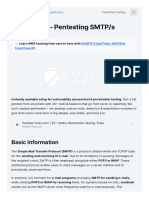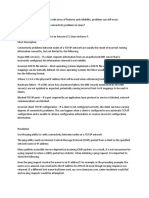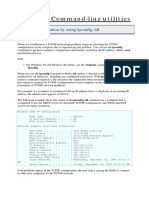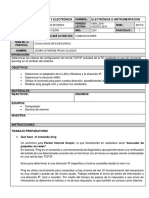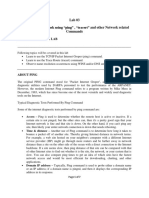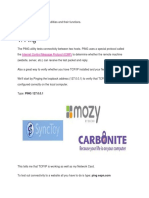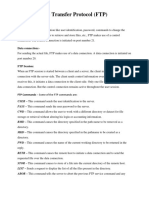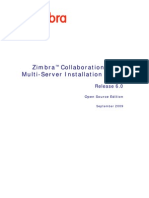PineApp OSG Anti-Spam Engines & Values
PineApp OSG Anti-Spam Engines & Values
Uploaded by
finaltoheaven1Copyright:
Available Formats
PineApp OSG Anti-Spam Engines & Values
PineApp OSG Anti-Spam Engines & Values
Uploaded by
finaltoheaven1Original Description:
Copyright
Available Formats
Share this document
Did you find this document useful?
Is this content inappropriate?
Copyright:
Available Formats
PineApp OSG Anti-Spam Engines & Values
PineApp OSG Anti-Spam Engines & Values
Uploaded by
finaltoheaven1Copyright:
Available Formats
PineApp OSG Anti-Spam Engines & Values
The control over the OSG Anti-Spam /Anti-Botnet engines
By Clicking on the above Edit icon Admin will allow engine activation and deactivation
Enable SMTP Traffic Bypass
When active the system will act as a router and push any incoming packet forward .
1. IP rate limit
The system allows you to limit maximum messages and sessions per source IP per
Min/Hr/Day
PineApp OSG accept TCP connection
PineApp OSG consult it's database about following parameters:
o Number of allowed TCP connections from clients source IP per Min/Hr/Day
o Number of exists TCP connections from clients source IP per Min/Hr/Day
If Number of exists TCP connections from clients source IP per Min/Hr/Day exceeds the
numbers of allowed, incoming connection will be dropped.
PineApp Ltd. 8 Hata'asia Street, Nesher, Israel, 3660201, POB 285
T +972-4-8212321 F +972-4-8203676 E info@PineApp.com W www.PineApp.com
2. Real time Blackhole list
A DNSBL (DNS-based Blackhole List, Block List, or Blacklist; see below) is a list of IP
addresses published through the Internet Domain Name Service in a particular format.
DNSBLs are most often used to publish the addresses of computers or networks linked to
spamming; most mail server software can be configured to reject or flag messages which
have been sent from a site listed on one or more such lists.
This use case is relevant for inbound emails only.
Settings:
PineApp OSG accept TCP connection
PineApp OSG read from database DNSBL's domain name say dnsbl.example.net.
PineApp OSG detect client's IP addresssay, 192.168.42.23
PineApp OSG reverse the order of octets, yielding 23.42.168.192
PineApp OSG appends the DNSBL's domain name: 3.42.168.192.dnsbl.example.net.
Look up this name in the DNS as a domain name ("A" record).
DNS Server returns address. It indicates that the client is listed in Black list.
PineApp OSG drop connection
3. IP Reputation
The Reputation Service utilizes Commtouch's Recurrent Pattern Detection (RPD)
technology.
RPD is network-based malware detection and filtering solution for protecting against
modern attacks that are often launched as massive outbreaks in which millions of email
messages containing malware (e.g., spam, phishing, viruses, and worms) are distributed
during the short window of opportunity before malware signatures become available.
Settings:
PineApp OSG accept TCP connection
PineApp OSG pass to Commtouch software source IP address
Commtouch software return IP reputation (category)
Commtouch return GOOD IP reputation
PineApp OSG continue normal flow
PineApp Ltd. 8 Hata'asia Street, Nesher, Israel, 3660201, POB 285
T +972-4-8212321 F +972-4-8203676 E info@PineApp.com W www.PineApp.com
4. Greeting delay
A greeting delay is a deliberate pause introduced by an SMTP server before it sends the
SMTP greeting banner to the client. The client is required to wait until it has received this
banner before it sends any data to the server. (per RFC 5321 3.1). Many spam-sending
applications do not wait to receive this banner, and instead start sending data as soon as
the TCP connection is established. The server can detect this, and drop the connection.
Settings:
PineApp OSG accept TCP connection
PineApp OSG consult with DNS about IP type
DNS Server informs that it is dynamic IP.
PineApp OSG delay greeting to X sec.
PineApp OSG continue normal flow
5. Helo/EHLO Check
Per RFC 2821, the first SMTP command issued by the client should be EHLO (or if unsupported,
HELO), followed by its primary, Fully Qualified Domain Name. This is known as the Hello greeting. If
no meaningful FQDN is available, the client can supply its IP address enclosed in square brackets:
"[1.2.3.4]". This last form is known as an IPv4 address "literal" notation.
6. Pipelining checking
When a client SMTP wishes to employ command pipelining, it first issues the EHLO command to the
server SMTP. If the server SMTP responds with code 250 to the EHLO command and the response
includes the EHLO keyword value PIPELINING, Then the server SMTP has indicated that it can
accommodate SMTP command pipelining. Once the client SMTP has confirmed that support exists
for the pipelining extension,
The client SMTP may then elect to transmit groups of SMTP commands in batches without waiting
For a response to each individual command. In particular, the commands RSET, MAIL FROM, SEND
FROM, SOML FROM, SAML FROM, and RCPT TO can all appear anywhere in a pipelined command
group. The EHLO, DATA, VRFY, EXPN, TURN, QUIT, and NOOP commands can only appear as the
last command in a group since their success or failure produces a change of state which the client
SMTP must accommodate
PineApp Ltd. 8 Hata'asia Street, Nesher, Israel, 3660201, POB 285
T +972-4-8212321 F +972-4-8203676 E info@PineApp.com W www.PineApp.com
7. SSP
Simple Sender Policy in a mechanism that allows system to limit maximum messages generated by
a specific email sender and provides a penalty blacklisting for the sender.
Mail From, Penalty will be give to the specific sender that exceeded the number of allowed
mail emails he is allowed to send per give time frame.
Unique Mail From, Penalty will be give to the specific Ip address that exceeded the number of
allowed mail sender's emails he is allowed to host per give time frame.
SSP - MF Black List Time (In Second(
SSP - UMF Black List Time (In Second(
SSP - Enable Greylisting (On/Off(
SSP - MF Rate Limit per Hour/Minute/Second.
SSP - UMF Rate Limit per Hour/Minute/Second.
The Greylisting Mechanism
The SMTP protocol allows for temporary rejection of incoming messages. Greylisting is the
technique to temporarily reject messages from unknown sender mail servers. A temporary rejection
is designated with a 4xx error code that is recognized by all normal MTAs, which then proceed to
retry delivery later.
Greylisting is based on the premise that spammers and spambots will not retry their messages but
instead will move on to the next message and next address in their list. Since a retry attempt
means the message and state of the process must be stored, it inherently increases the cost
incurred by the spammer. The assumption is that, for the spammer, it's a better use of resources to
try a new address than waste time re-sending to an address that's already exhibited a problem. For
a legitimate message this delay is not an issue since retrying is a standard component of any
legitimate sender's server.
Settings:
PineApp OSG parses MAIL FROM directive
PineApp OSG consult it's database about pair: source IP; source e-mail
Pair source IP; Source e-mail not exist.
PineApp OSG add this pair to its database
PineApp OSG send temporarily reject message to sender MTA
PineApp Ltd. 8 Hata'asia Street, Nesher, Israel, 3660201, POB 285
T +972-4-8212321 F +972-4-8203676 E info@PineApp.com W www.PineApp.com
8. Validate MX record
A mail exchanger record (MX record) is a type of resource record in the Domain Name System that
specifies a mail server responsible for accepting email messages on behalf of a recipient's domain
and a preference value used to prioritize mail delivery if multiple mail servers are available. The set
of MX records of a domain name specifies how email should be routed with the Simple Mail Transfer
Protocol.
Settings:
PineApp OSG extracts sender's domain name from MAIL FROM directive
PineApp OSG query MX record from DNS server
MX record for domain not exists.
PineApp OSG drop clients connection.
MX record for domain exists.
PineApp OSG continue it normal flow
9. Validate sender SPF
Validate sender IP by comparing source IP with allowed SPF record.
o PineApp OSG get:
o IP address of the SMTP client that is emitting the mail.
o Domain portion of the "MAIL FROM identity.
o PineApp OSG build SPF DNS query and send it to DNS server
o PineApp OSG gets response and parses it.
o PineApp OSG get all allowed hosts and perform forward lookup to DNS server (get A record
for each server)
o Compare source IP address with IPs from step 4.
o None of IPs is not equal.
o PineApp OSG drop TCP connection
Source IP equal with IPs from step 4.
PineApp OSG continue it normal flow
o SPF record not found
o PineApp OSG continue it normal flow
PineApp Ltd. 8 Hata'asia Street, Nesher, Israel, 3660201, POB 285
T +972-4-8212321 F +972-4-8203676 E info@PineApp.com W www.PineApp.com
10. RCPT Tarpitting
Tarpitting will increase the delay between recipients within the same envelope, the more recipients
within the envelope, the bigger the delay is. The purpose of Tarpitting is to decrease mail from
spammers who very often use many recipients in one envelope.
Settings:
PineApp OSG extract RCPT TO directive
PineApp OSG count RCPT TO directive
Counter exceeded X
PineApp OSG postpones transmitting this directive to destination MTA for X second.
11. DHA attack:
A Directory Harvest Attack or DHA is a technique used by spammers in an attempt to find
valid/existent e-mail addresses at a domain by using brute force. The attack is usually carried out
by way of a standard dictionary attack, where valid e-mail addresses are found by brute force
guessing valid e-mail addresses at a domain using different permutations of common usernames.
These attacks are more effective for finding e-mail addresses of companies since they are likely to
have a standard format for official e-mail aliases (i.e. jdoe@example.domain,
johnd@example.domain, or johndoe@example.domain).
Settings:
PineApp OSG get RCPT TO email address and pass it to destination MTA
Destination MTA return that recipient not exist
PineApp OSG increment number of invalid recipients.
Number of invalid recipients more than some configurable value
PineApp OSG drop TCP connection
PineApp OSG save client IP in its dynamic black list and stops responding during some
configurable time.
PineApp Ltd. 8 Hata'asia Street, Nesher, Israel, 3660201, POB 285
T +972-4-8212321 F +972-4-8203676 E info@PineApp.com W www.PineApp.com
12. DoS attack
A denial-of-service attack (DoS attack) or distributed denial-of-service attack (DDoS attack) is an
attempt to make a computer resource unavailable to its intended users. One common method of
attack involves saturating the target (victim) machine with external communications requests, such
that it cannot respond to legitimate traffic, or responds so slowly as to be rendered effectively
unavailable. In general terms, DoS attacks are implemented by either forcing the targeted
computer(s) to reset, or consuming its resources so that it can no longer provide its intended
service or obstructing the communication media between the intended users and the victim so that
they can no longer communicate adequately.
Settings
Maximum concurrent connections per source IP
Maximum mails per single open connection.
Max recipients per mail
Max total concurrent connections
13. PineApp Recurrent Pattern Detection
PineApp Recurrent Pattern Detection (RPD) technology, based on the identification and
classification of message patterns, delivers the highest threat detection capabilities. The objective of
this document is to discuss the characteristics of such threats and the challenges facing
technologies that aim to mitigate these often malicious attacks, in addition to describing how the
RPD solution protects against all types of email-borne threats.
14. Helo rate limit
Per RFC 2821, the first SMTP command issued by the client should be EHLO (or if unsupported,
HELO), followed by its primary, Fully Qualified Domain Name. The system allows you to limit
maximum sessions per a given Helo name and Helo's per given source ip address.
PineApp OSG consults its database about following parameters:
Helo rate limit , Penalty will be give to the specific Helo name that exceeded the number
of allowed mail session he is allowed to open per give time frame.
Unique Helo rate limit, Penalty will be give to the specific Ip address that exceeded the
number of allowed mail Helo names it is allowed to host per IP per give time frame.
Helo rate limit Black List Time (In Second)
Unique Helo rate limit Black List Time (In Second)
Helo rate limit per Hour/Minute/Second.
Unique Helo rate limit per Hour/Minute/Second
PineApp Ltd. 8 Hata'asia Street, Nesher, Israel, 3660201, POB 285
T +972-4-8212321 F +972-4-8203676 E info@PineApp.com W www.PineApp.com
You might also like
- Free Comptia Network+ Study Guide by MC McseDocument48 pagesFree Comptia Network+ Study Guide by MC McseMalluNo ratings yet
- Jana 2 Server: Documentation by Lukas I.M. VanaDocument12 pagesJana 2 Server: Documentation by Lukas I.M. Vanamamamaria2009No ratings yet
- Email MX Customer PresentationDocument43 pagesEmail MX Customer PresentationsumitmohanguptaNo ratings yet
- Pentesting SMTP - S - 25,465,587 - HackTricksDocument17 pagesPentesting SMTP - S - 25,465,587 - HackTrickshisowo8015No ratings yet
- Email TracingDocument27 pagesEmail TracingSoumen DebguptaNo ratings yet
- Build Own Email Server With Linux ServerDocument53 pagesBuild Own Email Server With Linux ServerTaufikNo ratings yet
- Address Resolution Protocol (Arp) : Internet Protocol (Ip) Ip Network Addresses Ipv4 Is Used Over EthernetDocument3 pagesAddress Resolution Protocol (Arp) : Internet Protocol (Ip) Ip Network Addresses Ipv4 Is Used Over EthernetrodrohanNo ratings yet
- Mdaemon SettingsDocument4 pagesMdaemon SettingswawanNo ratings yet
- Computer Networks Lab (CL307) Lab Session 06: National University of Computer & Emerging ScienceDocument15 pagesComputer Networks Lab (CL307) Lab Session 06: National University of Computer & Emerging Sciencesnooker masterNo ratings yet
- TCP Ip CommandsDocument3 pagesTCP Ip Commandsdolon10No ratings yet
- Chapter 3 Scanning NetworksDocument39 pagesChapter 3 Scanning NetworksGetaneh AlehegnNo ratings yet
- Postfix HardeningDocument18 pagesPostfix HardeningDimitris Alyfantis100% (1)
- Teleport Freep BXDocument12 pagesTeleport Freep BXmuaphitruong_198No ratings yet
- Lab 3 DCNDocument17 pagesLab 3 DCNMuhammad Faiz MuhammadNo ratings yet
- Information GatheringDocument54 pagesInformation Gatheringhungnd24fptNo ratings yet
- EmailSecurity (2)Document82 pagesEmailSecurity (2)Saadie EssieNo ratings yet
- AWS DocumentDocument4 pagesAWS DocumentthahirhussainNo ratings yet
- Name: Salim Tadvi Reg No: 201070042: Computer NetworksDocument5 pagesName: Salim Tadvi Reg No: 201070042: Computer NetworksSALIM TADVINo ratings yet
- ScanningDocument20 pagesScanningshimazNo ratings yet
- Learning Nmap: The Basics: Rajesh Deodhar How-Tos Tools / Apps 1 CommentDocument5 pagesLearning Nmap: The Basics: Rajesh Deodhar How-Tos Tools / Apps 1 Commentksenthil77No ratings yet
- 1-Wire Shark-03-01-2024Document13 pages1-Wire Shark-03-01-2024deepalim348No ratings yet
- Evaluation of Some SMTP Testing, Email Verification, Header Analysis, SSL Checkers, Email Delivery, Email Forwarding and WordPress Email ToolsFrom EverandEvaluation of Some SMTP Testing, Email Verification, Header Analysis, SSL Checkers, Email Delivery, Email Forwarding and WordPress Email ToolsNo ratings yet
- Basic Network ConfigurationDocument7 pagesBasic Network ConfigurationYoseph ZinuNo ratings yet
- Ch4 Linux NetworkingDocument54 pagesCh4 Linux Networkinganimut0934No ratings yet
- Traditional Applications - Electronic Mail (SMTP, POP3, IMAP, MIME) - HTTP - Web Services - DNS-SNMPDocument39 pagesTraditional Applications - Electronic Mail (SMTP, POP3, IMAP, MIME) - HTTP - Web Services - DNS-SNMPanish.t.pNo ratings yet
- Module 4 CN PDFDocument18 pagesModule 4 CN PDFPrathameshNo ratings yet
- Exploring Novel Ways in Building Botnets: Daniel Mende & Enno Rey (Dmende, Erey) @ernw - deDocument67 pagesExploring Novel Ways in Building Botnets: Daniel Mende & Enno Rey (Dmende, Erey) @ernw - debettyKaloNo ratings yet
- SPAM Prevention Using DNS Solutions: Implementing Reverse Domain Name Services (RDNS) and Planning For SPF ClassicDocument35 pagesSPAM Prevention Using DNS Solutions: Implementing Reverse Domain Name Services (RDNS) and Planning For SPF ClassicBerrezeg MahieddineNo ratings yet
- FJJFNVDocument21 pagesFJJFNVRehman ZamanNo ratings yet
- Lab7 IAM302 LEQUANGDAT IA18BDocument6 pagesLab7 IAM302 LEQUANGDAT IA18Blequangdat2016No ratings yet
- CEH Module 3Document162 pagesCEH Module 3amandalire43No ratings yet
- SHORT (RECORDED) CCIE Security - Content Security ESA (INE-converted)Document58 pagesSHORT (RECORDED) CCIE Security - Content Security ESA (INE-converted)Ruei-Yu ZengNo ratings yet
- Suspicious Traffic DetectionDocument21 pagesSuspicious Traffic DetectionnagarjunaNo ratings yet
- Network+ Study GuideDocument51 pagesNetwork+ Study Guiderseara1127No ratings yet
- Network Command LineDocument9 pagesNetwork Command LineRonald MangeroNo ratings yet
- 1) Goto Tcode Rz10 or Rz11 and Check Parameters For SMTP Port & J2Ee - StartDocument39 pages1) Goto Tcode Rz10 or Rz11 and Check Parameters For SMTP Port & J2Ee - StartbvrchowdaryNo ratings yet
- Scot Configuration TroubleshootingDocument39 pagesScot Configuration TroubleshootingPrashanth PrashuNo ratings yet
- Scot ConfigurationDocument39 pagesScot ConfigurationsarandapNo ratings yet
- IT221 T Project Template - 1444Document9 pagesIT221 T Project Template - 1444Rr rNo ratings yet
- Simple Mail Transfer Protocol (SMTP)Document13 pagesSimple Mail Transfer Protocol (SMTP)PK SNo ratings yet
- Network Connectivity Checking Procedures and TechniquesDocument31 pagesNetwork Connectivity Checking Procedures and TechniquesLeonardo Noran Jr100% (1)
- Evaluation of Some SMTP Testing, SSL Checkers, Email Delivery, Email Forwarding and WP Email Tools: Evaluation of Some SMTP Testing, SSL Checkers, Email Delivery, Email Forwarding and WordPress Email ToolsFrom EverandEvaluation of Some SMTP Testing, SSL Checkers, Email Delivery, Email Forwarding and WP Email Tools: Evaluation of Some SMTP Testing, SSL Checkers, Email Delivery, Email Forwarding and WordPress Email ToolsNo ratings yet
- Assignment 13Document14 pagesAssignment 13aryanNo ratings yet
- Penetration Testing ToolsDocument24 pagesPenetration Testing ToolsMorteza ZNLNo ratings yet
- Test Network Connection With Ping and PathPingDocument2 pagesTest Network Connection With Ping and PathPingNazeerNo ratings yet
- Internet Protocols g10 Chs EdzDocument49 pagesInternet Protocols g10 Chs EdzJoan Sarahan100% (1)
- Build Your Own Email Server On Ubuntu: Basic Postfix SetupDocument19 pagesBuild Your Own Email Server On Ubuntu: Basic Postfix SetupBasuraNo ratings yet
- Informe Practica 1 IPconfig PingDocument7 pagesInforme Practica 1 IPconfig PingJazz PrunaNo ratings yet
- Dynamic Host Configuration ProtocolDocument5 pagesDynamic Host Configuration Protocolartsan3No ratings yet
- Netwoking GunDocument5 pagesNetwoking GunChishale FridayNo ratings yet
- Configure MX Records For Incoming SMTP E-Mail TrafficDocument6 pagesConfigure MX Records For Incoming SMTP E-Mail TrafficDaniel OlsonNo ratings yet
- Lab 03Document7 pagesLab 03Ihsan ul HaqNo ratings yet
- TutorialDocument2 pagesTutorialmhelpdeskNo ratings yet
- DNS (Domain Name Service) - TCP and Udp 53: The Hypertext Transfer Protocol (HTTP)Document13 pagesDNS (Domain Name Service) - TCP and Udp 53: The Hypertext Transfer Protocol (HTTP)Suraj Singh RajputNo ratings yet
- Sample Answers: Network Programming - Spring 2003 Midterm ExamDocument6 pagesSample Answers: Network Programming - Spring 2003 Midterm Examlm_zakaria4420No ratings yet
- Archivo ServaDocument9 pagesArchivo ServaAlfred LozaNo ratings yet
- WIA1005 Network Technology Foundation: Application Layer and Build A Small NetworkDocument33 pagesWIA1005 Network Technology Foundation: Application Layer and Build A Small NetworkAina NajihahNo ratings yet
- DecaDocument9 pagesDecaKen Archer SeleraNo ratings yet
- Quick Guide To SMTP ConfigurationDocument5 pagesQuick Guide To SMTP ConfigurationgagamelNo ratings yet
- CCNA 1 Chapter 10 v5.0 Exam Answers 2013: Physical LayerDocument7 pagesCCNA 1 Chapter 10 v5.0 Exam Answers 2013: Physical LayerAnastácia MelloNo ratings yet
- Network Management & AdministrationDocument13 pagesNetwork Management & AdministrationVipul KaniaNo ratings yet
- Evaluation of Some SMTP Testing, Email Verification, Header Analysis, SSL Checkers, Email Delivery, Email Forwarding and WordPress Email ToolsFrom EverandEvaluation of Some SMTP Testing, Email Verification, Header Analysis, SSL Checkers, Email Delivery, Email Forwarding and WordPress Email ToolsNo ratings yet
- FTP&E MailDocument8 pagesFTP&E MailsuneelkluNo ratings yet
- iPhoneConfigurationProfileRef PDFDocument59 pagesiPhoneConfigurationProfileRef PDF79iliostatyNo ratings yet
- Question Bank 150 Questions Computer NetworksDocument29 pagesQuestion Bank 150 Questions Computer Networksritikpandey0002355623No ratings yet
- Internet Fundamental NotesDocument163 pagesInternet Fundamental NotesAnuj Raj50% (4)
- Pentaho 3.7.0 Linux and MySQLDocument25 pagesPentaho 3.7.0 Linux and MySQLVincent LamNo ratings yet
- Zimbra OS Admin Guide 8.6.0Document208 pagesZimbra OS Admin Guide 8.6.0Danilo Rodrigues da SilvaNo ratings yet
- Fortimail Admin 620Document686 pagesFortimail Admin 620Miguel Angel Callupe MejiaNo ratings yet
- System Inetworking E-MailDocument56 pagesSystem Inetworking E-MailRen1453No ratings yet
- Zimbra OS Admin GuideDocument188 pagesZimbra OS Admin GuideCarlitos CustodioNo ratings yet
- CCNA Exploration 1 FINAL Exam AnsweDocument10 pagesCCNA Exploration 1 FINAL Exam Answeumar khanNo ratings yet
- Zimbra OS Multi-Server InstallDocument58 pagesZimbra OS Multi-Server InstallHidzuan HashimNo ratings yet
- Unit 5 CNDocument73 pagesUnit 5 CNHemasai 6909No ratings yet
- CN - 2 Marks Questions and SolutionsDocument23 pagesCN - 2 Marks Questions and Solutionsaccessgm100% (4)
- WebPower ManualDocument82 pagesWebPower ManualAriana MainieriNo ratings yet
- CR3000 Student WorkbookDocument538 pagesCR3000 Student WorkbookdyaNo ratings yet
- 102-400-Final Full Updated22112019Document49 pages102-400-Final Full Updated22112019duvenNo ratings yet
- Quick Scan Features Setup Guide: Xerox Workcentre 5222/5225/5230Document14 pagesQuick Scan Features Setup Guide: Xerox Workcentre 5222/5225/5230Cristian BobaruNo ratings yet
- Mail Enable Enterprise GuideDocument135 pagesMail Enable Enterprise Guideapi-3830738100% (1)
- SysCloud's Guide To Gmail BackupDocument69 pagesSysCloud's Guide To Gmail BackupSysCloudNo ratings yet
- CNT Questions WheeboxDocument16 pagesCNT Questions WheeboxJayesh MohiteNo ratings yet
- Final Exam PutraDocument20 pagesFinal Exam PutracrabmoetNo ratings yet
- Portfolio and Individual Report On Network Administration ManagementDocument52 pagesPortfolio and Individual Report On Network Administration ManagementDami YusuphNo ratings yet
- Lecture 15Document18 pagesLecture 1523wingsNo ratings yet
- Cisco Unity TraceDocument14 pagesCisco Unity TracehyderNo ratings yet
- Docu52397 SourceOne Email Management 7.1 SP1 Release NotesDocument133 pagesDocu52397 SourceOne Email Management 7.1 SP1 Release NotesLarry FoxNo ratings yet
- Internet Privacy Enhanced Mail: Essay 17Document19 pagesInternet Privacy Enhanced Mail: Essay 17Đức ThắngNo ratings yet
- Unit - 2 Application LayerDocument58 pagesUnit - 2 Application Layermemonabrar8460No ratings yet
- CS 3251-Computer Networking I:: Email and DNSDocument32 pagesCS 3251-Computer Networking I:: Email and DNSbvkdiggiNo ratings yet



